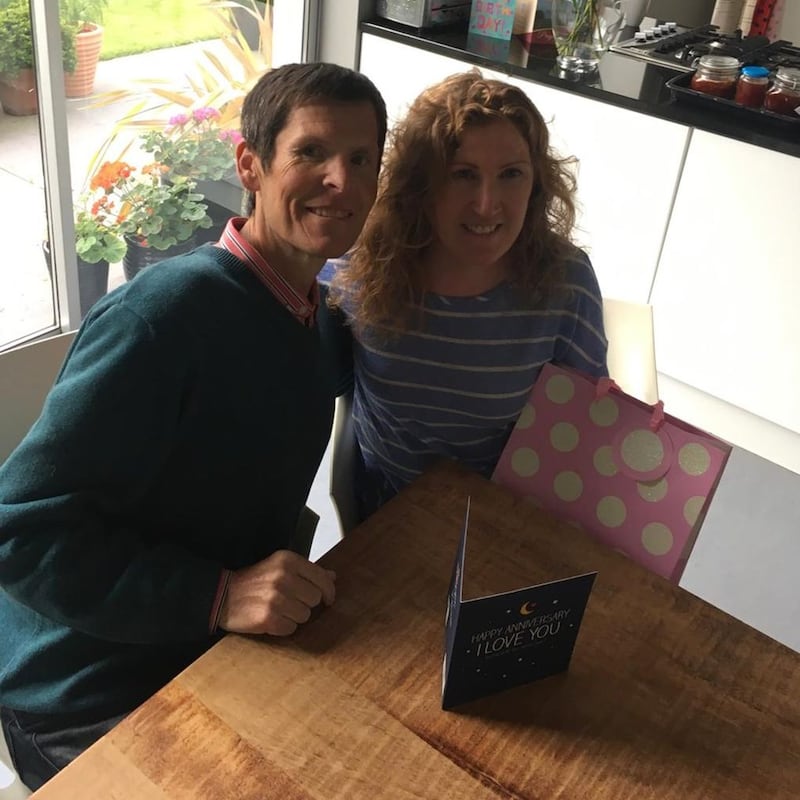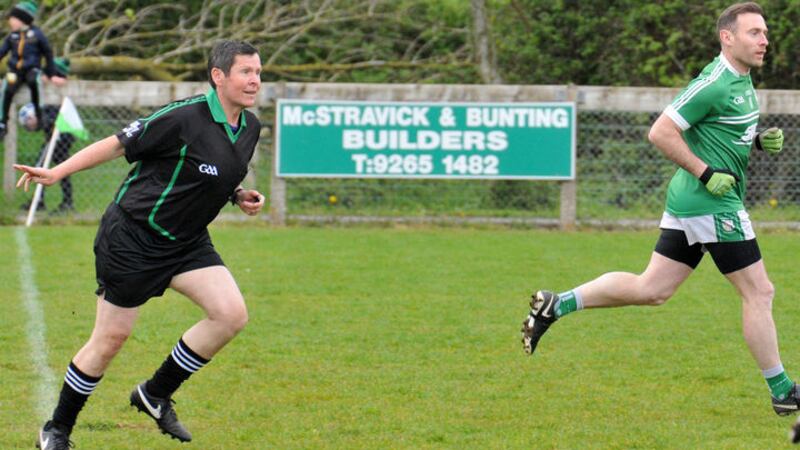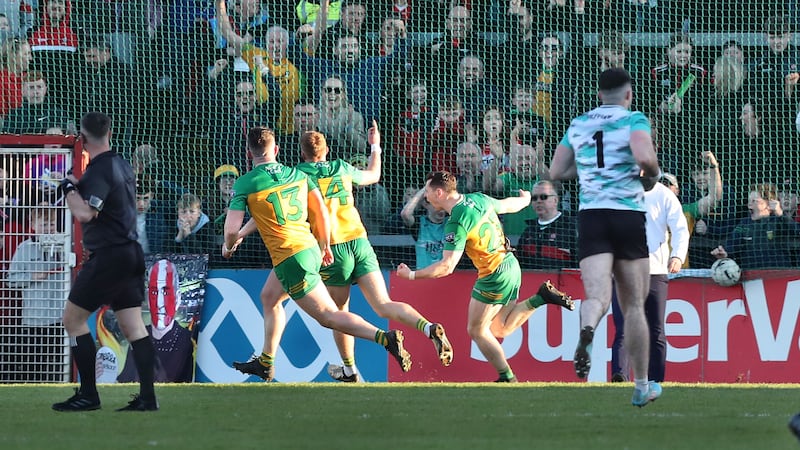“I’LL just nip to the toilet.”
Gregory Walsh is in his gown. Bloods taken. Shaved. He’s ready. Pumped, almost.
It’s been six full years since the first flu-like symptoms struck. The whole winter of 2011, he tried to shake it. But when it came to the fitness test for the national referees’ panel in mid-January, he just couldn’t do it.
In training, he hadn’t been able to get over 14.4 in the bleep test. That was a brave drop from the 16.2 he’d usually hit. Still, he thought the adrenaline of his place on the panel depending on it would take him through.
It didn’t.
He ran a few lines in the National League but when he got to the point of feeling like he had to swap with the fourth official during a game in Healy Park, the symptoms were beginning to look like something else.
Six years on, on December 29, 2017, he nips to the toilet in Papworth Hospital, the leading centre in the UK for patients with heart and lung disorders.
When he comes back, the transplant co-ordinator comes through the door.
“The transplant’s off.”
Gregory had been on the waiting list for a heart transplant. The call had come at 5am that morning. The taxi was at his door at 8am to take him to Belfast City Airport. From there, he and wife Catherine flew to East Midlands.
There’s an ambulance car waiting. It’s 100 miles from there to Papworth. They did it in 55 minutes.

At 4.30pm, the co-ordinator came up to say they were ready for him, and that they’d go and get him a wheelchair to bring him to theatre.
By the time he came back from the toilet, the heart they’d removed from a donor to put in his body had gone into cardiac arrest.
“The co-ordinator said it was the first time it had ever happened him in 20 years – they checked the heart before they take it out of the donor and everything looked fine, looked great.
“But just as they were taking it out, it took a cardiac arrest. It was a shock. Looking back, he probably said the right thing – ‘it’s a good thing. If it hadn’t taken a cardiac arrest when we took it out, we could have put it in you and then…’ In a way, somebody was looking down on me to say ‘this isn’t the one’.”
It’s four days after Christmas. Gregory thought he’d got through the festive occasion alright at home. Felt he was lucid, in good form.
“After the transplant, my family told me I spent half the day sat in the chair just doing nothing.”
He’d attacked the whole illness with a positive mindset. But it had begun to take its toll.
His weight had gone from 12-and-a-half stone down to 8-and-a-half. The broad shoulders that were his trademark had fallen in. His good suit drowned him. He went down two clothes sizes and started to wear slim-fit shirts to hide the weight loss.
“I was down to slim fit shirts that I’d never wear and could never fit into. You’re wearing it to try and make you look full. But there’s still a wee thin neck coming out of it. It’s hard to disguise.”
He needed crutches to get out of bed.
It’s in hindsight that he realises the only thing that kept him going was the fact that every evening since they got married and the kids came along, he, Catherine, Rose (11) and Dominic (9) sat down at the family table for their tea.
“I was eating maybe one meal a day. I wasn’t eating anything until teatime. I’d no appetite.
“The only reason I ate at teatime was because we all sat down for teatime at the table, as a family. I wanted to keep that going.
“At some stages I was forcing myself to eat, because I wanted to eat for the family, for my children and my wife.”
With the operation cancelled, the Walshs were told that they’d be kept until another suitable donor was found.
That was on December 29. It didn’t take long. At 4pm on the 31st, the knock on the door came.
“They came up again and said they thought they had another heart available that would suit. That was amazing. You got a real lift again.
“They said they wouldn’t know until 10pm if it was a good match and it was ok. It was about 11pm they said it was ok, but that they wouldn’t go ahead until the next day.”
The reason for that was that the donor was giving multiple organs, and so other recipients had to be brought in.
And so they lay on top of the hospital bed, looking out at the Cambridge skies at the Hogmanay fireworks going off. Slept a little while from 11 until the noise woke them. When it went off, so did they.
This time there was no hiccup. On New Year’s Day, Gregory was taken into theatre at 10am. When Catherine next saw him, it was 2.30am the following day. The operation had been slightly delayed, but taken 10 hours in total.
Six years after being diagnosed with Dilated Cardiomyopathy, a condition that enlarged his heart and reduced its working capacity to 15 per cent, he had a new heart.
* * * * * * * * * * * * *
IT was doing a Corn na nÓg final in Castledawson that Gregory Walsh finally caved.
When he’d failed the fitness test a few months earlier, it was time to hit up his GP. First up were antibiotics for a possible chest infection.
“I went to the doctor three times in two weeks because it wasn’t getting any better.”
Eventually they put him down the line of a chest x-ray, though the waiting list was over two months. He went to the Ulster Clinic just shy of Easter 2012, on a Thursday night.
The x-ray was clear, but the consultant said he’d spotted something that he’d pass on to the cardiac specialists. The following Monday, he got a call telling him to come for an ultrasound scan. Into hospital the following day, where he stayed for three weeks.
“They saw the heart had enlarged. At the start, they were trying to see what had caused it. They thought it was maybe a virus that had damaged the heart muscle.”
He was still trying to referee but the Corn na nÓg game was his last.
“I’d put a heart monitor on. I found it was hard to keep up with the game, difficult to stay with the pace. Especially young fellas, the way they go straight up and down the field rather than across the field. I wasn’t recovering, my legs felt heavy all the time.
“It was knowing myself I should be doing better and wasn’t. I can’t explain it. You knew you could run faster, but you couldn’t do it.”
Walsh had been a player, coach, secretary and now referee for his club Aghagallon, though he now lives in Lurgan, just the other side of the county divide with Armagh.
He’d always been fit and healthy. Once he’d been diagnosed, doctors prescribed medication that stabilised him until the summer of 2015, but when his condition started to deteriorate, he was referred to Papworth.
By the time he first went over in November that year, the tests they did on his heart function delivered some bad news.
“They told me I was too ill to go on the transplant list.”

It was quickly arrested. They changed his medication and it worked to the point where he came out the other side. He was on the transplant list after a few weeks, and within three months he’d been taken off it again because he was well enough.
“They always said they don’t want to do the operation until you need it. Because I’d improved, they wanted to keep the old heart in as long as possible.
“Once they put the new heart in, the clock starts ticking again. If you were well enough, they’d hold off until you need it.”
Having been constantly monitored by Dr Carol Patton at Craigavon Hopsital in between time, it was the middle of 2017 before the deterioration really began. By the end of June, he was struggling to cut the grass or walk 200 yards across the road to his mother-in-law’s house.
“I just felt my legs starting to get heavy. I started to get sore knees. A lack of energy just. Everything was going downhill.
“In Papworth you’re always in contact, so in November ’17 they brought me over again and did the tests again and said they’d put me back on the transplant list.”
Within a matter of weeks, he was on the operating table. And from there, it became about getting back on the pitch.
* * * * * * * * * * * * *
THE 12 stone frame is filled out again, the 49-year-old’s shoulders back at themselves.
When he first stepped out of the hospital bed after the operation, it was the lack of pain in his knees that struck Gregory Walsh.
“We still didn’t know how well the operation had gone until three or four days later when they got me up out of the bed.
“The first thing I noticed was that there were no pains in my legs again. All the pains in my knees were gone.
“It was the first time I thought to myself it had really improved my condition, it had really worked.”
There was a bit of rejection of the heart last May, discovered during one of the 15 biopsies taken at Papworth on his new heart during the first year.
That knocked him back briefly, but it was quickly treated. There’s a muscle that can’t be corrected that means he has to give his heart time to warm up when he starts exercising as the blood flow is that bit slower to catch up.
But that won’t stop him. Having served as a referees’ tutor in the early part of his illness, he was invited on to the national referees’ advisory panel.
Last month, he took charge of his first football match as a referee again in six years when his own club, Aghagallon, played Cargin in a reserve game.
His aim as a referee is to do a game in each of the nine counties of Ulster over the next few months in a bid to raise funds for Papworth’s non-beating heart programme, which enables surgeons to use donor hearts which were previously not viable.
Fewer than half of the 250 people a year in need of a heart transplant in the UK find a viable donor in time. This programme aims to eat into that figure.
But before he’s a referee, he’s a husband and father. Seeing Rose and Dominic in Clann Eireann jerseys rather than Aghagallon ones took him a while to digest, but by this stage Gregory’s in helping with their under-10s.
He’s one of the lucky ones.
* To donate to Gregory’s appeal, visit https://www.justgiving.com/fundraising/gregory-walsh2



